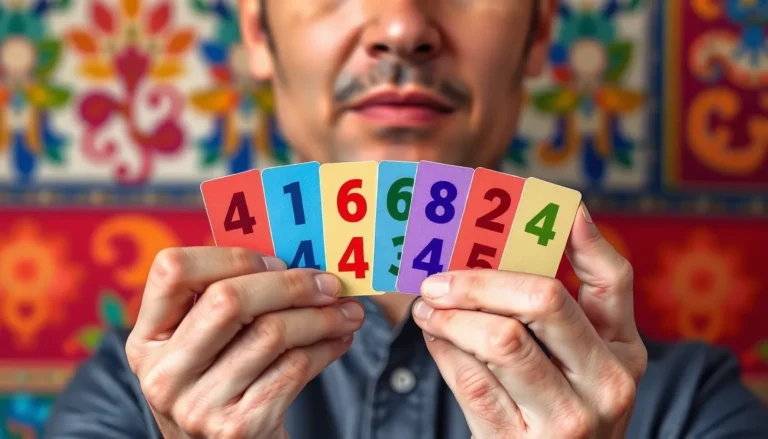Table of Contents
ToggleEvery great story has that one scene that makes you laugh, cry, or question your life choices. Scene analysis dives deep into these pivotal moments, uncovering the magic behind the dialogue, visuals, and emotions that keep audiences glued to their seats. Whether it’s a heart-wrenching breakup or an epic battle scene, understanding the nuances can turn a casual viewer into a cinematic detective.
Imagine dissecting your favorite movie like a chef slicing into a perfectly cooked steak. Each layer reveals flavors and textures that elevate the experience. By mastering scene analysis, anyone can appreciate the artistry involved in storytelling, making even the most mundane moments feel like Oscar-worthy performances. So grab your popcorn and let’s explore the art of scene analysis—because who doesn’t want to sound smarter at the next movie night?
Overview of Scene Analysis
Scene analysis plays a crucial role in understanding films. This process allows viewers to dissect moments, uncovering the depth of storytelling techniques.
Definition of Scene Analysis
Scene analysis refers to the breakdown of specific moments in films to evaluate their components. This involves examining dialogues, cinematography, acting, and emotional undertones. Analysis enables individuals to identify how these elements contribute to the overall narrative. By focusing on specific scenes, viewers grasp the director’s intentions and the film’s thematic significance.
Importance of Scene Analysis
The significance of scene analysis lies in its ability to deepen appreciation for filmmaking. Viewers gain insights into character motivations through careful study. Each scene’s emotional impact becomes clearer, facilitating a richer understanding of the story. Engaging with scene analysis helps audiences articulate their perspectives and enhances discussions during movie nights. By appreciating the nuances of a scene, viewers cultivate a more profound connection to the film and its creators.
Techniques Used in Scene Analysis

Understanding techniques in scene analysis enhances interpretation. Analyzing various components reveals deeper meanings within films. Below are two main categories of techniques.
Traditional Methods
Character evaluation stands as a key traditional method. Focus shifts to examining dialogues, actions, and expressions. Script analysis uncovers hidden intentions and subtext. A close reading of screenplays offers insights into character arcs. Contextual cues reveal historical or cultural influences on the narrative. Additionally, shot composition analysis contributes to the understanding of visual storytelling. Evaluators dissect camera angles, framing, and movement to reveal emotional resonance. Music and sound also play significant roles in traditional scene analyses, shaping audience feelings and reactions.
Modern Approaches
Digital tools revolutionize modern scene analysis. Software allows scene breakdowns that streamline the evaluation process. Visual mapping aids in dissecting sequences and maintaining structural integrity. Online communities foster collaborative analysis, where fans share insights and techniques. Exploring thematic elements through social media discussions broadens perspectives, encouraging diverse interpretations. Furthermore, virtual reality offers immersive experiences that enhance understanding of spatial dynamics. Integrating data analytics into analysis strengthens viewer engagement, highlighting trends and patterns in audience reception. Modern approaches empower viewers with innovative ways to appreciate and discuss films.
Applications of Scene Analysis
Scene analysis extends beyond film and influences various fields, including media and artificial intelligence.
In Film and Media
In film and media, this analysis enhances storytelling by revealing character motivations and thematic elements. Critics frequently employ scene analysis to dissect pivotal moments, providing deeper insights into plot development. Academics also utilize this approach to teach narrative techniques and cinematic language. Emotionally charged scenes receive particular attention, illustrating how visuals and dialogue intertwine to evoke responses. Furthermore, scene analysis enriches viewer experience by fostering appreciation for craftsmanship in filmmaking. Engaging with scenes this way can help audiences identify recurring motifs and influences across different works. Critics and enthusiasts alike benefit from applying these methods to invoke richer conversations about films.
In Robotics and AI
Robotics and artificial intelligence increasingly embrace scene analysis to improve perception and understanding of environments. Robots equipped with advanced sensors analyze their surroundings, enabling them to detect objects and interpret spatial relationships. AI systems use scene analysis to process visual data, aiding in tasks like navigation and obstacle avoidance. Machine learning algorithms often learn from annotated scene data, enhancing their ability to make decisions based on visual input. In smart environments, scene analysis facilitates human-robot interaction, as machines adapt to changing contexts and respond accordingly. These advancements exemplify the growing importance of scene analysis in developing intelligent systems that interact seamlessly with the world.
Challenges in Scene Analysis
Scene analysis faces multiple challenges that can complicate its effectiveness and accuracy. Understanding these obstacles is essential for deepening one’s analytical skills.
Environmental Factors
Environmental factors significantly influence scene analysis. Lighting plays a key role in setting the tone and mood within a scene, affecting how viewers interpret emotional cues. Weather conditions, such as rain or fog, can enhance or obscure visuals, providing additional layers of meaning. Various atmospheric elements impact character actions and interactions, shaping narrative outcomes. Cultural contexts also matter, as societal norms and values can alter audience perceptions of specific scenes. These factors need careful consideration during analysis, as they contribute to the richness and complexity of filmmaking.
Technology Limitations
Technology limitations pose challenges for comprehensive scene analysis. Traditional analytical methods may not fully capture intricate details, leaving gaps in understanding. Software tools, though useful, often struggle with subjective interpretations of emotions and themes. Algorithmic biases can hinder accuracy, misrepresenting character dynamics or thematic intentions. Video quality variations, especially in older films, complicate the analysis process, as reduced clarity affects visual assessments. Ensuring tools and technologies can effectively analyze scenes remains critical, as they enhance viewer engagement and comprehension.
Future Trends in Scene Analysis
Scene analysis continues evolving with the integration of advanced technologies and emerging research. Such shifts significantly enhance the understanding and appreciation of film.
Advances in Technology
Artificial intelligence and machine learning are transforming scene analysis methodologies. Real-time analytics tools help dissect scenes, examining elements like pacing and emotional tone. Improved image recognition systems allow for detailed examination of visual components, enhancing storytelling insights. Software that analyzes sound design creates a richer understanding of audio effects on audience reactions. Virtual and augmented reality further immerse audiences, providing new ways to experience cinematic moments. Collectively, these technological advancements elevate scene analysis beyond traditional methods, offering deeper layers of exploration.
Emerging Research Areas
New research in scene analysis focuses on viewer response and emotional engagement. Investigations into neuroscience explore how specific scenes activate emotional pathways in the brain. Additionally, studies examining the impact of cultural context reveal how different backgrounds influence scene interpretation. Cross-disciplinary approaches incorporate psychology, media studies, and cultural analysis for a more comprehensive understanding. Research into interactive storytelling also addresses viewer agency, examining how different choices affect perception of scenes. As these fields expand, they contribute to a more nuanced appreciation of cinematic narratives.
Scene analysis serves as a powerful tool for viewers seeking to deepen their understanding of film and media. By dissecting pivotal moments and exploring emotional nuances, audiences can connect more profoundly with the stories being told. As technologies advance and methodologies evolve, the potential for enhanced engagement grows.
Embracing both traditional and modern techniques allows individuals to appreciate the artistry behind cinematic storytelling. This journey into the intricacies of scene analysis not only enriches the viewing experience but also fosters a greater appreciation for the creators and the messages they convey. Whether for personal enjoyment or academic exploration, scene analysis opens doors to a world of insight and emotional resonance.




